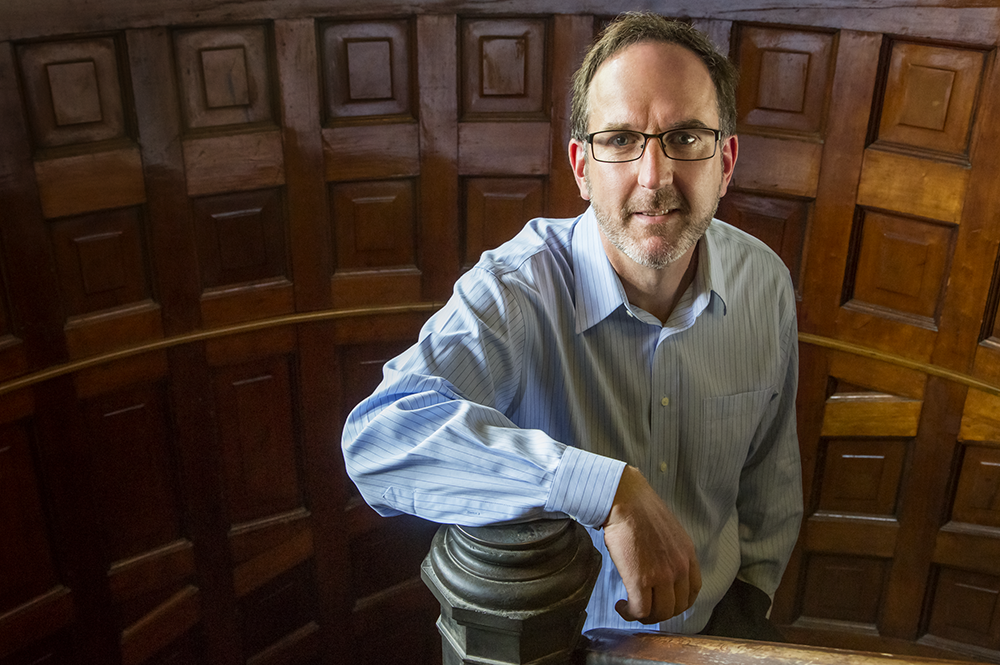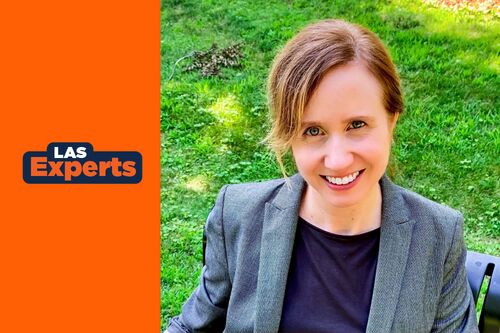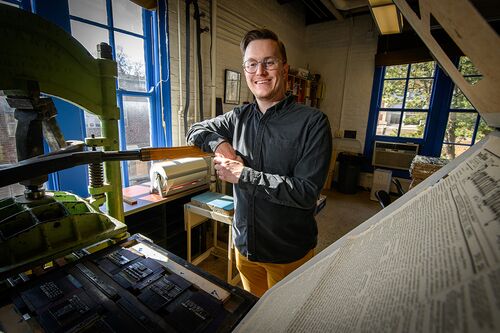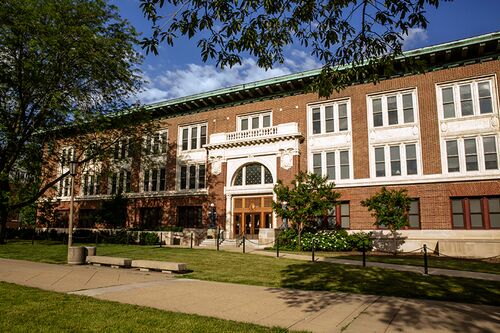Writing for sustainability

What’s one item you use every day that you couldn’t live without? Mascara, Nike sneakers, paper towels, or perhaps your daily Starbucks coffee? But what happens to these items once you toss them (or their containers) out?
This is one question that English professor Gillen Wood asks students in his English 360: Environmental Writing course, the first in a series offered to complete the newly implemented and interdisciplinary Environmental Writing Certificate.
“Students find out where the materials come from, the manufacturing process, its consumption, and then its disposal, and how most of it ends up in landfills,” he said.
The Environmental Writing Certificate launched in Fall 2017 and is the only opportunity of its kind in the country due to the publication component required in the capstone course, said Gillen, who directs the new program. The certificate is a joint offering through the Department of English, the School of Earth, Society, and Environment, and the Institute for Sustainability, Energy, and Environment (iSEE).
To receive the certificate, students will complete English 360: Environmental Writing, English 477: Advanced Environmental Writing, and English 498: Environmental Writing for Publication, which includes publishing a magazine. The certificate also offers a 400-level course in multimedia communication skills.
The certificate itself resulted from increasing student demand, as the first environmental writing course filled up each semester with a waiting list.
“There’s a real market among students who desire entering into this social project of communicating the urgency of sustainability and the sustainability mission to the whole public,” Gillen said.
Around 90 students have taken certificate courses this year. They hail from a broad range of disciplines and majors, including global studies, mathematics, and engineering. Professors Jamie Jones and Spencer Schaffner, from the Department of English, and Rob Kanter, a clinical associate professor from SESE, are also helping teach courses.
“It’s incredible, the commitment. It’s very encouraging and inspiring, the amount of dedication students have,” Gillen said. “They see, perhaps in a way the older generation has been slow to understand, that communication and public engagement are absolutely key to moving the needle behind all these issues.”
The capstone course, Environmental Writing for Publication, will be tied to launching a magazine called “Q” which is a play on the big questions posed throughout the new program. Each issue of the magazine will be devoted to addressing a question about sustainability and the environment, and will exclusively feature writing from students in the classes.
The magazine will be published twice a year, and it will be funded and staffed by iSEE. The first issue is on track for publication Fall 2018.
“In environmental science, we’re overwhelmed by data and research but there seems to be kind of a shortfall of communication,” Gillen said, adding that the base knowledge in the field doubles every five years. “So this is a way of training a new generation of writers and communicators who can take all this data and translate it, communicate it to the general public in an effective way.”
Students engage in research-based, science writing for the magazine, but the certificate includes an interconnected approach to sustainability by including other relevant topics such as culture and politics.
“What I said to my students in the capstone course is, ‘Don’t think of this as a conventional student/professor relationship, or as a conventional classroom,’” he said. “‘Think of us more in the office of a magazine staff. I’m the editor, you’re the writers, you’re the talent, and we’ve got this deadline for our first magazine.’”
Taylor Jennings, a junior majoring in global studies and English, is currently in Environmental Writing for Publication and has also taken Advanced Environmental Writing. She’s collaborated with students from a variety of majors.
“I love working with Gillen — he’s very constructive and critical of my pieces,” she said. “He says, “Well, if we are trying to aim at a general readership then there’s more you have to do than just write well.”
For the magazine, Jennings is working on a piece that combines her own personal narrative and involvement with an NGO along with research and interviews with experts in the field.
“Advanced Environmental Writing was framed as, ‘If you ever want to write for National Geographic, come take this class’— and that’s a goal of mine, to write for National Geographic,” Jennings said. “And I’ve told Gillen a million times that’s kind of my goal. He said, ‘OK let’s frame your writing in a way that would prepare you for that so you can really set that goal.’”
“You get out of these classes what you put into them,” she added. “It’s a very personalized experience.”
Aside from acting as professor, Gillen, who has served as an English professor for 18 years, is the editor-in-chief of the magazine, as well as the director of the certificate. He has also recently taken the position of associate director for education and outreach at iSEE.
Sponsoring the Environmental Writing Certificate and launching “Q,” however, represents a broader shift in his interest in climate change. Gillen is the author of “Tambora,” a historic account of the eruption of Indonesia's Mount Tambora in 1815 and its lasting effects on Earth’s climate. The book received high praise from the Chicago Tribune, The Washington Post, among others.
Now, Gillen is working on another book about the discovery and voyages to Antarctica in 1840, as well as the continent’s geological and climatological history.








